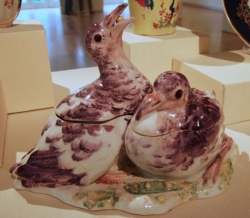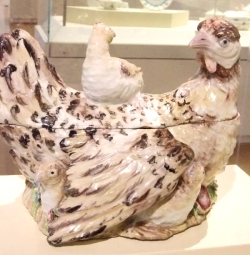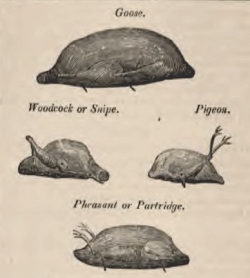-
History of:
- Resources about:
- More:
- Baby walkers
- Bakehouses
- Bed warmers
- Beer, ale mullers
- Besoms, broom-making
- Box, cabinet, and press beds
- Butter crocks, coolers
- Candle snuffers, tallow
- Clothes horses, airers
- Cooking on a peat fire
- Drying grounds
- Enamel cookware
- Fireplaces
- Irons for frills & ruffles
- Knitting sheaths, belts
- Laundry starch
- Log cabin beds
- Lye and chamber-lye
- Mangles
- Marseilles quilts
- Medieval beds
- Rag rugs
- Rushlights, dips & nips
- Straw mattresses
- Sugar cutters - nips & tongs
- Tablecloths
- Tinderboxes
- Washing bats and beetles
- Washing dollies
- List of all articles
Subscribe to RSS feed or get email updates.
When dinner was served up, the soup tureen was a goose, the butter-boats a pair of ducks, the salt-cellers foot-tubs, with handles, staves, and hoops, all cut in glass; and I observed, among other animals on my blue-and-white plate, a pig feeding out of a trough. After the cloth was removed, I began to expostulate, at some length, with my cousin upon his bad taste, enumerating the many deplorable evidences of it, and entreating him, in the mildest manner in the world, to throw them behind the fire. To my astonishment he let me know they were quite the fashion every where......
from Mr. P's Visit to London, The Monthly Magazine, New York 1822
Tureens & taste
Ceramic poultry and game at the dining table
 Bird-shaped tureens were popular in the 18th century, and have never completely gone out of fashion since.
These English
duck- and hen-shaped tureens from 1755 have plenty of appeal today, even though
we have become rather coy about the link between real animals, butchers, and our
food. At least one current US company offers
similar dishes for your dining table.
Bird-shaped tureens were popular in the 18th century, and have never completely gone out of fashion since.
These English
duck- and hen-shaped tureens from 1755 have plenty of appeal today, even though
we have become rather coy about the link between real animals, butchers, and our
food. At least one current US company offers
similar dishes for your dining table.
 But who would choose to adorn their table
with
this tureen from Liverpool? The stoneware trussed goose with eyes, beak
and claws says a bit too much about life and death for most of us to want it in
the dining room. Even the "how to" illustrations in 19th century cookery books left
the head
off, though descriptions of how to examine the birds when
shopping were
quite explicit.
But who would choose to adorn their table
with
this tureen from Liverpool? The stoneware trussed goose with eyes, beak
and claws says a bit too much about life and death for most of us to want it in
the dining room. Even the "how to" illustrations in 19th century cookery books left
the head
off, though descriptions of how to examine the birds when
shopping were
quite explicit.
Geese - The bill and feet of a young one will be yellow, and there will be but few hairs upon them; if old, they will be red: if fresh, the feet will be pliable; if stale, dry and stiff. Geese are called green till three or four months old. Green geese should be scalded: a stubble-goose should be picked dry.
Maria Rundell, New System of Domestic Cookery, 1814
 This French
18th century duck-shaped tureen suggests that fashions in France
and England were not too different. By the 19th century English serving dishes were
often abundantly decorated with ceramic fauna.
Game pie dishes, among others, were ornamented with "images
of sumptuous game animals", implying wealth and status in an era when partridge
and hare were reserved for well-to-do wealthy landowners.
This French
18th century duck-shaped tureen suggests that fashions in France
and England were not too different. By the 19th century English serving dishes were
often abundantly decorated with ceramic fauna.
Game pie dishes, among others, were ornamented with "images
of sumptuous game animals", implying wealth and status in an era when partridge
and hare were reserved for well-to-do wealthy landowners.
 14 November 2007
14 November 2007
You may also like:
Culinary antiques: cooking and dining
Game pie dishes
You may like our new sister site Home Things Past where you'll find articles about antiques, vintage kitchen stuff, crafts, and other things to do with home life in the past. There's space for comments and discussion too. Please do take a look and add your thoughts. (Comments don't appear instantly.)
For sources please refer to the books page, and/or the excerpts quoted on the pages of this website, and note that many links lead to museum sites. Feel free to ask if you're looking for a specific reference - feedback is always welcome anyway. Unfortunately, it's not possible to help you with queries about prices or valuation.


